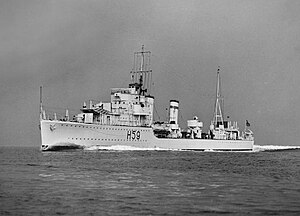 Gallant in April 1938
| |
| History | |
|---|---|
| Name | Gallant |
| Ordered | 5 March 1934 |
| Builder | Alexander Stephen and Sons, Glasgow |
| Laid down | 15 September 1934 |
| Launched | 26 September 1935 |
| Completed | 25 February 1936 |
| Identification | Pennant number: H59 |
| Motto | Nobis Mare Patria: 'The sea is our Fatherland ' |
| Fate | Sunk as a blockship, September 1943 |
| Badge | On a Field Blue, a female head proper crowned with scallops shells Gold. |
| General characteristics (as built) | |
| Class and type | G-class destroyer |
| Displacement | |
| Length | 323 ft (98.5 m) |
| Beam | 33 ft (10.1 m) |
| Draught | 12 ft 5 in (3.8 m) |
| Installed power |
|
| Propulsion | 2 shafts, 2 geared steam turbines |
| Speed | 36 knots (67 km/h; 41 mph) |
| Range | 5,530 nmi (10,240 km; 6,360 mi) at 15 knots (28 km/h; 17 mph) |
| Complement | 137 (peacetime), 146 (wartime) |
| Sensors and processing systems | ASDIC |
| Armament |
|
HMS Gallant (H59) was a G-class destroyer, built for the Royal Navy in the mid-1930s. During the Spanish Civil War of 1936–1939 the ship spent considerable time in Spanish waters, enforcing the arms blockade imposed by Britain and France on both sides of the conflict. Gallant was transferred from the Mediterranean Fleet shortly after the beginning of World War II to the British Isles, to escort shipping in local waters. She was slightly damaged by German aircraft during the evacuation of Allied troops from Dunkirk at the end of May 1940. Following repairs, Gallant was transferred to Gibraltar and served with Force H for several months. In November, the ship was transferred to the Mediterranean Fleet, where she escorted several convoys. She struck a mine in January 1941 and was towed to Malta for repairs. These were proved extensive and Gallant was further damaged by near-misses during an air raid in April 1942, before they were completed. The additional damage made the ship uneconomical to repair so she was scuttled as a blockship in 1943. Her wreck was broken up in 1953.